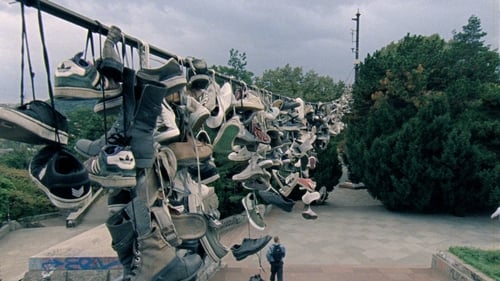
Writer
Some kids in Brussels play a game based upon objects that were brought back from the Congo and which were used during the Hutereau expedition.

Director
Some kids in Brussels play a game based upon objects that were brought back from the Congo and which were used during the Hutereau expedition.

Director
What kind of futures can be read in the impersonal fragments of our reality? It’s a question that inevitably gains attention and importance when it’s posed to those who the future, pre-eminently, belongs to. Already in her debut film, Little Figures (2003), Sarah Vanagt gauged the historical imagination of children by inviting immigrant children to improvise an imaginary conversation between three historical figures, immortalized as statues, in Brussels. Fifteen years and many transformations later, she decided to reverse the question and ask children to read the future in the elusive imprints of their city. Onto countless abstract patterns, brought to life with the help of an old magic lantern, children from Brussels, Athens and Sarajevo project their own impressions, dreams and fears. The result is a form of “magical reading”, as the perception of unforeseen correspondences and constellations that confront us with the undercurrent of the present.

Director
In the 17th century, Antoni Van Leeuwenhoek, a draper from Delft, begins to make glass lenses, in order to better study the quality of his textile. He melts, drips and grinds small beads of glass. His tiny lenses are so bright and have such magnifying power that the draper seems to have entered a new dimension. Is he the first to see little moving ‘animals’ in a drop of water? How to describe something that nobody ever saw before? In the film 'Every Tear', Sarah Vanagt starts a journey into her home city of Brussels, with Leeuwenhoek’s microscope in hand. She picks up bits and pieces on her road, and tries to find out what the first microscopic images may have looked like. She replaces the lens of her camera by the 17th-century lens. As she is filming, she wonders why we always look for shapes that we already know, whenever we are in the eye of the unknown.

Director
With the publication of the Ophthalmographia in 1632, the Amsterdam physician Vopiscus Fortunatus Plempius sheds new light on the age-old question of how seeing works. His answer is an invitation to experiment: Enter with me into a darkened room and prepare the eye of a freshly slaughtered cow. He emphasizes that anyone may carry out this experiment, at home, "demanding little effort and expense." “And you, standing in the darkened room, behind the eye, shall see a painting that perfectly represents all objects from the outside world,” promises Plempius. In the short film In Waking Hours we see historian Katrien Vanagt - who studied the Latin writings of this Plempius - cloaked in the skin of a 21st-century disciple of Plempius. Her cousin, filmmaker Sarah Vanagt, is there and captures how this modern "Plempia" meticulously follows her teacher's instructions. Thus, in a dark kitchen in Brussels, they become witnesses at the birth of images upon the eye.

Director
The ghostly "invisible mothers" of early photography.

Cinematography
Gottland provides an unconventional look at Czechoslovak 20th century history. Inspired by the bestselling book “Gottland” from the Polish journalist Mariusz Szczygiel, this feature-length film is comprised of short stories portraying peculiar fates. Young documentary film makers from renowned Prague Film School FAMU, inspired by the book, take a closer look at the history of post-war Czechoslovakia and Czech Republic, in order to discover new heroes and remind us of the ones that were forgotten or erased from the history.

Director
While the former Serbian leader Radovan Karadžić is being tried at the International Criminal Tribunal for the former Yugoslavia in The Hague, Sarah Vanagt inspects the courtroom using paper, pencil and chalk. When the courtroom is empty between sessions, she places sheets of paper on top of objects and then scrapes a pencil back and forth across them to reveal the underlying surface structures. It’s a technique that produces images in their plainest form.

Director
Three statues on the Mont des Arts in Brussels: a king, a queen and a medieval knight. Three newcomers to Brussels: a Philippino boy, a Rwandan refugee girl and a Moroccan boy. Three statues, three children; an imaginary conversation.






